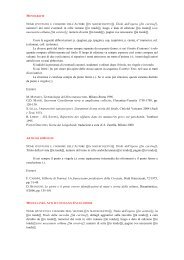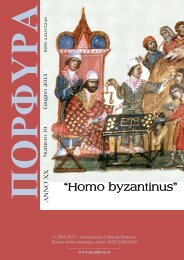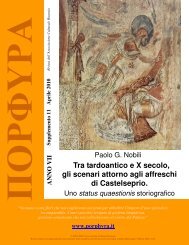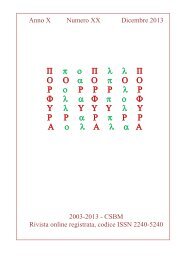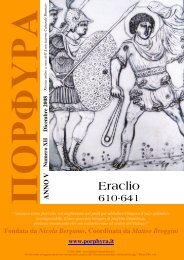ΠΟΡΦΥΡΑ - Porphyra
ΠΟΡΦΥΡΑ - Porphyra
ΠΟΡΦΥΡΑ - Porphyra
Create successful ePaper yourself
Turn your PDF publications into a flip-book with our unique Google optimized e-Paper software.
A Prôtospatharios, Magistros, and Strategos Autokrator of 11 th cent.<br />
the equipment of Georgios Maniakes and his army according to the Skylitzes Matritensis miniatures<br />
and other artistic sources of the middle Byzantine period.<br />
magyar Steppes and in the South-Russia since the first iron age<br />
(8-6 th cent. B.C.) 168 . Tipologically this kind of bit seems to have<br />
a separate origin in comparison with other harness pieces,<br />
although we can suppose that it was used by the East-Romans<br />
underinfluenced by Eurasiatic Steppes People 169 .<br />
The East Roman horses, especially those of the high<br />
commanders, were furnished with bronze or golden phalerae. 170<br />
On antilìna we have posed two bronze cruciform harness pieces<br />
(one by side), copied by those of Roumenian Fortresses (fig.9 n.<br />
11) 171 . This kind of harness piece is very similar in its<br />
decoration to the harness found in People steppe burials so that<br />
we can not say how much it was of East Roman influence upon<br />
the horse harness steppes Peoples serving as mercenaries in<br />
Roman Army or vice versa. On fig.9 n. 15 we have<br />
reconstructed an example of metal mount for bridles with the<br />
specimen of Svetorazevo, from Danube 172 , undoubtedly of East-<br />
Roman provenance.<br />
The postilìna is decorated by a bronze harness (fig.9 n.<br />
14), coming from Dinogetia Garvan. 173 It consists of a central,<br />
circular and convex part, decorated on the edge with a series of<br />
small roundels, and 4 semi-circular arms like rings arranged in a<br />
cruciform way, to which ends 4 thongs, closed in that point,<br />
were linked. We can suppose two of these fittings, for both parts<br />
of the back strip, and their shape could suggest that they could<br />
be employed also for the fastening of a second transversal strap<br />
posed on the horse back. 174<br />
The saddle system of East-Roman horsemen of this<br />
168 Gallus-Horvăth, Un peuple cavalier préscythique en Hongrie, in Dissertationes Pannonicae, seria II, 9, Budapest,<br />
1939, pl. XLVI n. 6, LI n. 10 and LXXIV nn. 7-9.<br />
169 Or may be a similar influence. We should not forget that the different ethnic composition of the East-Roman<br />
soldiers and mercenaries led to the use of their own weapons harnessed together with items derived from Imperial<br />
arsenals, see Kolias, Waffen, p. 34-35, 134.<br />
170 Senior East-Roman commanders have got gold phalerae on their horse harnesses; cfr. the episode, quoted by Leo<br />
Diakonos, p. 148, of the death of the Magistros Ioannes Kurkuas at the battle of Silistra by the hand of the Russians of<br />
Svjatoslav di Kiev, where he is thought as the Emperor for the gold harness and fàlara of his horse.<br />
171 Stefan-Barnea-Cosma, Dinogetia,p. 345, fig 40 p. 77 n. 11 and 184 p. 346 n. 7; dated to the 11 th century; it is a<br />
circular cruciform equal arms object with a total length of 5,3 cm. In the middle we have a semi-sphere, whose convex<br />
face is decorated by a half-circle in relief, including a point, a screw roundel or a small cruciform prominence. The<br />
same pattern appears on the cross arms. The bigger roundel of the centre circumscribes a rosette. On the concave back<br />
opposite to the cruciform are preserved 5 small trimming nails, through which the passage of thongs could be fixed. On<br />
the asiatic-nomad origin of these cruciform asiatic fittings see Fettich N., Die Metallkunst der Landnehmenden Ungarn,<br />
in Archeologia Ungarica XXI, Budapest 1937 pp. 204-208 and pls. XXI-XXIII-XXV- XCVII.<br />
172 Vetnic S., Medieval weapons and implements deriving from the Middle Morava basin, in Balcanoslavica 10, 1983,<br />
p. 152 fig. 8; dated to the 10-11 th century; it has got the form of a double eight and rosette in the middle. Size 6x3,5 cm.<br />
173 Stefan-Barnea-Cosma, Dinogetia,p. 347 and fig 184 p. 346 n. 14; dated to the 11-12 th centuries, it is a little bit<br />
bigger (6,8 cm.) than that cruciform represented on the antilìna; it can be compared to it however it differs formally and<br />
functionally. Similar specimens in Pletnyeva S.A., Pecheneghs, Turks and Polovskji in South-Russian Steppes, in<br />
Trudy Volgo-Donskoi Archeologiskegoj Ekspedicii, I, Materialy i issledovanije po archeologii URSS, 62, Moscow<br />
1958 p. 159 and figg. 4/1, 2 ; Pletnyeva S.A., Nomadic Graves in Sarkel-Belaja-Veia, in Trudy Volgo-Donskoi<br />
Archeologiskegoj Ekspedicii, III, Materialy i issledovanije po archeologii URSS, 62, Moscow 1963, 109, pp. 216-259,<br />
p. 255 and figg. 27/4,5 Artamonov, Sarkel-Belaja-Veia, p. 77-82 and fig. 57.<br />
174 In the Skilitzés we have such a large representation of different kind of harness decoration, it is difficult to attribute<br />
the use of a single specimen to a part or any other part of the harness.<br />
30



